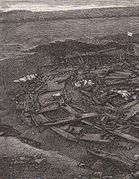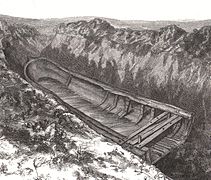Crannóg in Buiston Loch
The Crannóg in Buiston Loch (pronounced bɪstən - also known as Buston, Biston, Mid Buiston, Lochside and Swan Knowe) was located in Buiston Loch south of Stewarton , north of Kilmaura, in East Ayrshire in Scotland . The natural lake in a dead ice hole about 100 m in diameter was an often-flooded depression in the low-lying pastureland near Mid Buiston Farm, east of the A735 road.
The excavations of the Crannóg took place in 1880–81 and 1989–90 and was documented by Duncan McNaught (discoverer - 1845–1925), Robert Munro (excavator - 1835–1920) and others.
The structure consisted of a raft of layers of stone and twigs held in place by rings of stakes and connected by wooden beams both radially and concentrically . The diameter was about 25.2 m. A house was built on the platform. It appears to have been over 15 m in diameter, with walls made of wood and stone and a central hearth over 3 m in diameter. The artifacts (in the National Museum of Antiquities of Scotland) consist of awls, bronze pegs, iron knives and dies, a cylindrical glass bead , two gold spiral finger rings, pebbles, bone combs, spear and arrowheads , whiskers, polishers, a slider, whetstones, a false Samian shard , E-goods and ceramics, probably of Franconian origin. A forgery of a tremissis (gold coin) from the 7th century was also found. The remaining but indeterminable finds fit into the 7th century.
- Crannóg in Buiston Loch
A dugout canoe over 7.0 m long with an inserted stern was found next to the crannóg.
Recent excavations show that despite the drainage of the hole and the subsequent excavation in the 19th century, extensive relics still survived. Radiocarbon dating indicates that the Crannóg was built during the period of Roman occupation, but dendrochronological analysis of the timbers shows that most of it dates from the first half of the 7th century.
The use on the Crannóg consisted of a single round house and analyzes have given insights into the conditions under which the structure was inhabited. A range of organic artifacts, primarily wood and leather, have been recovered, complementing the rich inorganic artifacts recovered during the 19th century excavation.
literature
- Nicholas Dixon: The history of crannog survey and excavation in Scotland. In: The International Journal of Nautical Archeology. Vol. 20, No. 1, 1991, ISSN 0081-1564 , pp. 1-8, doi : 10.1111 / j.1095-9270.1991.tb00289.x .
- John Barber, B. Anne Crone: Crannogs a diminishing resource? A survey of the crannogs of South West Scotland and excavations at Buiston crannog. In: Antiquity. Vol. 67, No. 256, 1993, ISSN 0003-598X , pp. 520-533, doi : 10.1017 / S0003598X00045737 .
Remarks
- ↑ A crannóg is a round artificial island made of tree trunks, sand and stones . Crannógs were built in the western parts of the British Isles from the Neolithic . Eilean Dhomhnaill in Loch Olabhat on the Scottish island of North Uist is perhaps the oldest Crannóg. The ceramic type Unstan Ware and 14 C dates prove its Neolithic origin between 3,650 - 2,500 BC. Chr.
Web links
- Entry on Crannóg in Buiston Loch in Canmore, Historic Environment Scotland database
Coordinates: 55 ° 39 '32.4 " N , 4 ° 31' 12.3" W.



